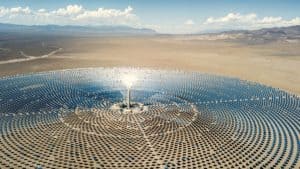
Concentrated solar power (CPS) has the potential to lower the cost of renewable energy and provide highly available dispatchable energy at any time of the day.
The National Renewable Energy Laboratory (NREL) and the Department of Energy (DoE) are both working on the next generation of CPS facilities as part of the DoE’s plans to reach an energy cost goal of 5 cents per kWh, a press statement reveals.
In the road to achieve this goal, U.S. government agency awarded NREL $2 million to develop a prototype for a system that can harness the great energy potential of molten salts while taming their corrosive properties.
What is concentrated solar power?
Concentrated solar power (CPS) uses a large array of mirrors, or heliostats, to direct sunlight into collection towers that store that energy in the form of heat in sand, rocks, or molten salt. As it incorporates long-lasting thermal heat storage, it can dispatch energy at any time of the day, and it’s particularly useful in areas that might rely on traditional solar PV energy (solar panels) during peak hours. Demand for energy typically peaks near sundown when solar panels start to produce less energy — a phenomenon known as the duck curve.
